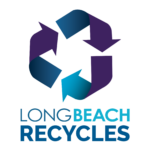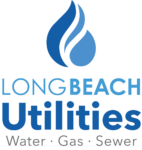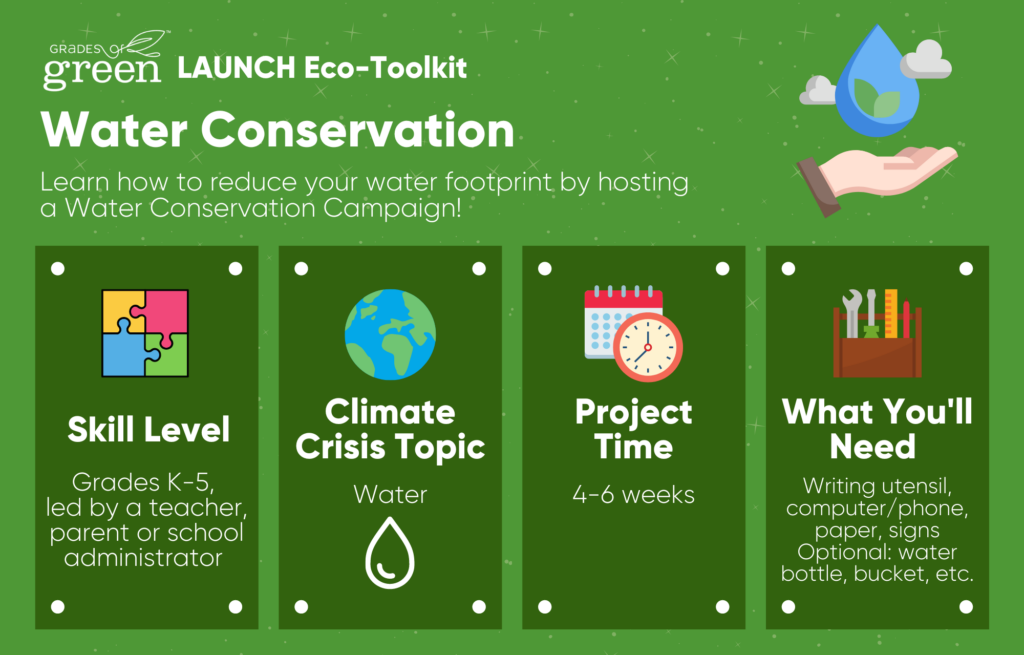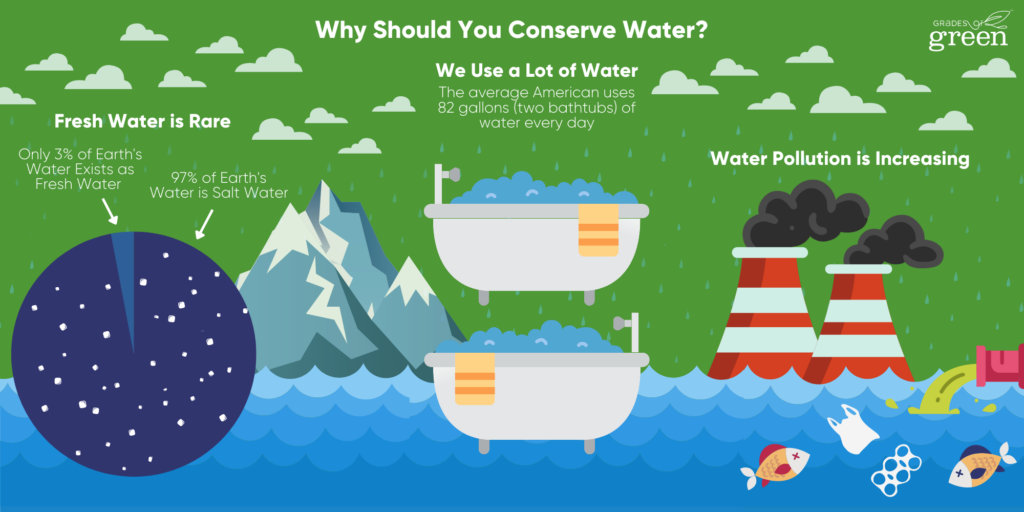Stop the drought monster by conserving water!
Water is essential to every living thing in the world. This means that saving, or conserving, as much water as possible is crucial to the betterment of our communities. By changing your daily habits and prioritizing conservation, you can reduce the amount of water you use so other living things can flourish!
Want to use this toolkit in Español? Click here!
Want to download this toolkit as a PDF? Click here!




Toolkit Details


NGSS
This toolkit address the following Science and Engineering Practices (SEPs) within the Performance Expectations of NGSS for Grades: K-2 and 3-5
- Asking Questions and Defining a Problem
- Planning and Carrying out Investigations
- Analyzing and Interpreting Data
- Using Mathematics and Computational Thinking
- Constructing Explanations and Designing Solutions
- Obtaining Evaluating, and Communicating Information
Learning Objectives
- Analysis
- Students will analyze their daily habits to see where they can reduce their water usage.
- Project Management
- Students will keep track of how much water they are saving.
- Students will practice leadership skills by delegating tasks to each other.
- Evaluation and Assessment
- Students will track and evaluate the impact of their project.
Why It’s Important
Conserving water is crucial for our future. By conserving clean water, we can:
- Prepare for, or even stop, future droughts
- Increase water for others, as it is essential to all humans, plants, and animals
- Save energy
What You Will Accomplish
Students will reduce their water usage by implementing different consumption habits in their daily lifestyle. They will also:
- Save money on family utility bills (water and electric!)
- Build awareness of water-use habits and discover how much we use every day
- Develop gratitude for the clean, reliable water you have
What is the City of Long Beach Doing to Conserve Water?
In 2015, Governor Jerry Brown created rules to conserve water in California. In 2017, Long Beach followed and created rules for large gardens. Any new garden project over 500 square feet or any existing garden over 2,500 square feet has to follow these new rules. These rules help ensure people use a smaller amount of water to prevent droughts, which have occurred in Long Beach in the past.
Conserving water is a community effort. Along with encouraging residents to save water at home, the City of Long Beach has its own plan for receiving water outside of the Colorado River, which is where most Southern California cities receive their water.. Long Beach sits on top of two underground aquifers, or underground rock that allows water to pass through, (West Coast Basin and Central Basin) and has legal rights to pump out about 33,000 acre-feet of groundwater each year from the Central Basin with plans to pump more out from the West Coast Basin. This source provides city residents with about 60% of the water from Long Beach Water. The City currently has 24 active wells to pump water from the Central Basin with plans to construct 12 more wells. This asset would allow Long Beach to have a safe source of freshwater in a region plagued with severe droughts. You can track the progress of one of these wells here! Check back for updates from Long Beach Water!
Educator Project Plan
Follow the steps below to set up a successful Water Conservation Campaign at your school! Need help? Contact us!
Track your metrics and submit your impact after implementing this toolkit. Your feedback helps keep our programs free for all across the globe.
Determine Participants
Use our Water Conservation Sign Up Sheet Template
- A Student Group such as (a club, before/after school program, non-school organization)
- A whole class
- The whole school
- Working with a small group of students? Plan to conserve water with your class!
- Working with a larger team? Plan to conserve water throughout your whole school!
Why Should You Conserve Water
The resources provided below can be shown as a slideshow or printed out as individual worksheets for students to review.

Fresh Water is Rare
Of all the water on Earth, only 3% exists as freshwater, while the remaining amount is salt water located in our oceans. Furthermore, only 0.5% of earth’s freshwater is usable by humans, since a majority is either frozen or deep underground. [1]
We Use a Lot of Water
It may not seem like it, but the average American uses 82 gallons of water every day [2]. That is enough water to fill up a full-size bathtub twice! If you count every single day in a year, the average American uses nearly 30,000 gallons of water annually. This is more than what Long Beach Water Services wants you to use. The Long Beach Water Department has a target of 55 gallons per person per day due to our most current drought status. On a global scale, humans use 4 trillion cubic meters of water every year. [3]
Water Pollution is Increasing
Remember that water is used for a variety of industries in addition to maintaining our daily health. Every product requires water for manufacturing, which leads to unwanted pollution. In fact, the UN estimates that 80% of sewage systems–in developing countries–are left untreated and pollute local lakes, rivers, and coastal regions. This can be seen with the many wastewater spills and overflows at some of Los Angeles’ water treatment facilities in recent years, such as at Hyperion and LA County Sanitation District.
Why Water is a Social Justice Issue
In some places, there is not enough water because it doesn’t rain much, causing people to pay more for water. In addition, some cities are not fixing their water systems. One example is in South Los Angeles, where they have had problems due to redlining. Redlining is when people are pushed to live in certain neighborhoods because of their skin color. In South Los Angeles, the government did not invest enough in their water systems. Factories were also built in this area causing a lot of pollution. The Los Angeles River, which flows through Long Beach, used to have concrete around it to stop flooding, however it’s not as full as it used to be. Some people are worried because they believe the county isn’t saving enough groundwater. The City of Long Beach depends on this clean water, but we need to save water in order for it to last. They have plans to bring nature back to the river or cover it with concrete, but waiting too long to make a decision gets riskier the more we wait. In many places, people cannot wash their face or water their garden due to water rationing. We need to find ways to save water and help everyone enjoy collected rainwater.
Watch this Short Video to Learn More on Reducing Water at School
Think About It!
Pre-Activity Questions
- Where do you see water being used the most?
- What do you think happens to water after it’s used or wasted?
- Describe a time where you saw water being wasted or overused.
- Why do you think conserving water is important?
- Teachers! Please track this metric: *Do you know any water-saving tips or practices your family follows at home?*
- Check out this Activity Booklet for K-2 grade students from the City of Long Beach Featuring Conservation Caper!
- Check out this Activity Booklet for 3-5 grade students from the City of Long Beach Featuring Conservation Caper!
Take Action: How to LAUNCH a Water Conservation Campaign
Lead students through the “Water Conservation Campaign” activity with guided instructions. Check out “Pro Tips” for additional help.
1. Gain Participants
- Determine who and how many students/staff are participating.
- Invite attendees to support your efforts.
- Use the Water Conservation Sign Up Sheet to track additional participants.
2. The Pre-Analysis
Using the Water Footprint Calculator, have each student calculate the amount of water they use. Have each student document this number by using the Water Conservation Pre-Analysis worksheet so they can compare their results at the end of the toolkit.
- Use water footprint calculator to measure water usage
- Fill in answers using Water Conservation Pre-Analysis Worksheet
3. Gather Your Materials
Before you start conserving water, gather all of the materials you need to reduce your water use:
- Print worksheets and resources
- Print or make signs
- Get writing utensil
- Get items to reduce water
- Bucket
- Water bottle
- Etc.
4. Conserve Your Water at School
Now it’s time to start conserving at your school! Create classroom guidelines and actions on how you can reduce your school’s water footprint. Some actions you can take include:
- Bringing a reusable water bottle
- Look for leaking pipes/faucets
- Turn off the sink when using soap to wash your hands
- Clean surfaces with buckets of water instead running the faucet
- Ask the school to install a water refill station
Put reminders around the classroom or your home (ex: near sinks) so you don’t turn on the faucet – you’ll be amazed at how automatic reaching for the knob is!
5. Conserve Your Water at Home
Now it’s time to start conserving at home! Be sure to track how much water you are using with the Water Conservation Tracker worksheet. There are many ways you can conserve water in your home. Use some of these examples to reduce your water footprint:
- Take shorter showers
- Use reusable water bottles
- Turn off your faucet when brushing your teeth or washing dishes
- Reduce watering gardens
- Obtain a rain barrel
- Reduce amount of car rides
- Reduce electricity use
- Reduce meat consumption
6. Measure Your Water Usage
After 1 month, have students redo the Water Footprint Calculator Quiz and see how much water they consumed in a month. Compare these new results with your previous ones and calculate the amount of water they reduced using the Water Conservation Tracker. Add the total amount of water conserved to report your impact!
7. Get the Word Out
Educate the school on how important it is to reduce their water consumption. Have students report your results and let others know what actions they took to reduce their water consumption. They can do this by using the infographics and facts provided above and speaking during morning announcements, speaking during lunch, or conducting a walking assembly!
Reflection Questions
How’d It Go?
- What changes do you see in students’ water use?
- Where did you see water being the most wasted?
- Will you change your water habits as a result of the project? If so, how?
- Have you made any changes in how you use water at home or school after learning about water conservation? If so, what changes have you made?
Report Students’ Impact
Congratulations!! You’ve implemented Water Conservation! Don’t let all that hard work go unnoticed. Submit your results by clicking the green button below.
Project ongoing? No problem! Let us know what you’ve done so far.
By reporting your impact, Grades of Green can:
- CELEBRATE and elevate your students’ hard work and success.
- Offer our programs FREE for all students across the globe.
- AWARD stipends and certificates to hard-working educators and students.
Please take a few minutes to submit your results. Thank you!
Provided Resources
- Water Conservation Sign Up Sheet Template
- Water Pre-Analysis Worksheet
- Water Conservation Tracker
- Water Footprint Calculator
- Water Conservation Slides
- Water Conservation Wrap Up Form
- Toolkit Resources – Google Drive Folder
Congrats on completing the Water Conservation Eco-Toolkit!
Did you enjoy this toolkit? Find your next project here!